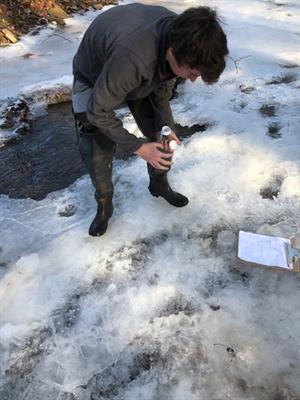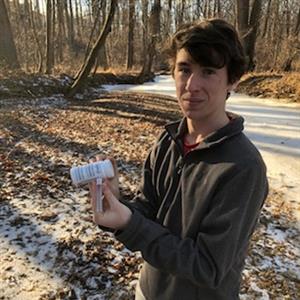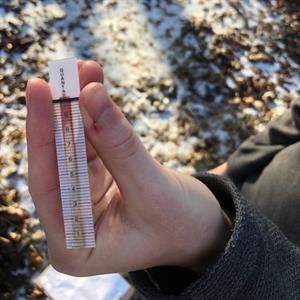By Ben Bowman, IWLA Intern
 We have recently been experiencing ice, snow, and freezing temperatures in Maryland (as has most of the country). Something most people probably aren’t thinking about during these deep freezes is the threats posed to water quality and stream health. The primary threat is road salts, which deposit extreme amounts of chloride into our waterways. One way in which we can track how much chloride we are releasing into our waterways is by running chloride chemical tests. These tests are performed through the use of chloride test strips, which can determine the approximate chloride concentration in a body of water in five minutes or less.
We have recently been experiencing ice, snow, and freezing temperatures in Maryland (as has most of the country). Something most people probably aren’t thinking about during these deep freezes is the threats posed to water quality and stream health. The primary threat is road salts, which deposit extreme amounts of chloride into our waterways. One way in which we can track how much chloride we are releasing into our waterways is by running chloride chemical tests. These tests are performed through the use of chloride test strips, which can determine the approximate chloride concentration in a body of water in five minutes or less.
During the 2017-2018 school year, I am interning at the Izaak Walton League, where I am learning about water quality monitoring and helping out with the Clean Water Challenge. During the past three months, I have been monitoring chloride concentrations in Muddy Branch, a stream that runs next to the Izaak Walton League national headquarters. Muddy Branch is a tributary of the Potomac River and part of the Chesapeake Bay watershed. Several major roads and highways pass over the stream, making it a hot spot for chloride due to road salts, construction, and other non-point sources of pollution.

December brought the first snowfall of this winter, as well as the first applications of road salts, and the chloride concentration in Muddy Branch (and many other of valuable waterways) became dangerously high. The December 2017 average chloride concentration was approximately 226.36 parts per million (ppm), and it reached 279 ppm at its highest point. This is nearly a 100 ppm rise in chloride concentration from November 2017, when the average chloride concentration at the same location was only 130.93 ppm.
So far, January 2018 has been even worse than December. Some of the first chemical tests of the New Year revealed chloride concentrations as high as 592 ppm in Muddy Branch! This number may continue to rise as winter storms ravage the East Coast of the United States, causing poor road conditions and the application of road salts in response.

Every stream or river located near a roadway is at risk for chloride concentration increases due to road salts. These increases make survival difficult for fish, amphibians, macro invertebrates, and other organisms that rely on waterways as a primary habitat. Prolonged exposure to excessive chloride is dangerous to these sensitive freshwater organisms. The Environmental Protection Agency classifies chloride concentrations of 230 ppm or greater as dangerous to aquatic life. The data I have collected shows how easily this threshold is exceeded.
Curious how road salts are affecting your local streams? Visit the League’s Save Our Streams web page for more information on monitoring and how to get started.